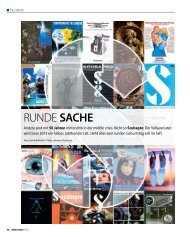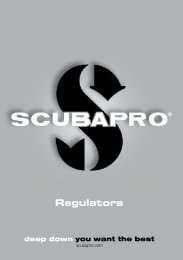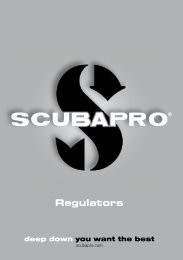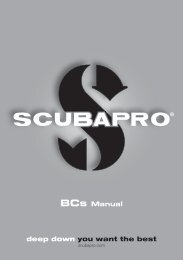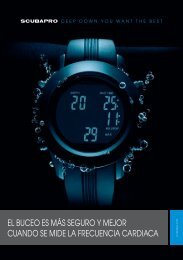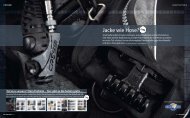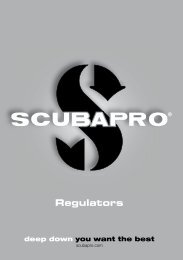Buoyancy Compensators manual - Scubapro
Buoyancy Compensators manual - Scubapro
Buoyancy Compensators manual - Scubapro
- No tags were found...
You also want an ePaper? Increase the reach of your titles
YUMPU automatically turns print PDFs into web optimized ePapers that Google loves.
out in low temperature conditions (lower than 10°C (50°F)). Cylinders must be transportedaccording to local rules provided for the transport of dangerous goods. Cylinder use issubjected to the laws regulating the use of gases and compressed air.4. Equipment must be serviced by qualified personnel at the prescribed intervals. Repairsand maintenance must be carried out by an Authorized SCUBAPRO Dealer service facilityand with the exclusive use of original SCUBAPRO spare parts.5. Should the equipment be serviced or repaired without complying with proceduresapproved by SCUBAPRO or by untrained personnel or not certified by SCUBAPRO, orshould it be used in ways and for purposes other than specifically designated, liability forthe correct and safe function of the equipment transfers to the owner/user.6. The content of this <strong>manual</strong> is based upon the latest information available at the time ofgoing to print. SCUBAPRO reserves the right to make changes at any time.7. All dives must be planned and carried out so that at the end of the dive the diver will stillhave a reasonable reserve of air for emergency use. The suggested amount is usually50 bars (725 psi).SCUBAPRO refuses all responsibility for damages caused by non-compliance with theinstructions contained in this <strong>manual</strong>. These instructions do not extend the warranty or theresponsibilities stated by SCUBAPRO terms of sales and delivery.! WARNINGAlways perform a pre-dive and post-dive inspection of the BC.4. GENERAL INFORMATIONPrimary purpose of the <strong>Buoyancy</strong> CompensatorThe primary purpose of a <strong>Buoyancy</strong> Compensator is to make you more comfortable byenabling you to maintain neutral buoyancy at depth.You are neutrally buoyant when you maintain a specific depth without expending significantphysical effort to prevent an ascent or descent from that depth.! WARNINGDo not use your BC as an assist or “lift bag” for bringing objects to the surface. Theseobjects may be lost during the ascent, creating a sudden increase in buoyancy andloss of buoyancy control.5. INITIAL SET UPLow Pressure (LP) hoseConnect the low pressure (LP) hose of thePower Inflation Valve or A.I.R. 2 to an unusedLP port of the first stage, that must have thesame thread (fig. 1).fig. 14



